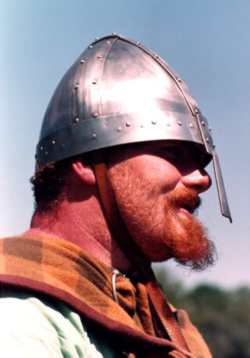 |
It is inescapable that in a bloodthirsty age they were more bloodthirsty than most, but the mask of enduring ferocity slips a little when you consider that the people that did the writing were those that stood between the Vikings and their silver - the clerical staff of churches and abbeys.
Let us look briefly at the roots and achievements of the Viking age.
When the very distant ancestors of the Vikings reached the end of their long migration from - probably - the Indus valley, they ran into a real problem. The sea. They were a nomadic people from an area with few areas of open water and certainly with no seaboard. Yet, within a few generations, they seem to have invented more or less from scratch a design of hull that became common throughout Europe for several centuries. It is possible to follow a line of development through previous boat designs found on the European west coast, but around the beginning of the seventh century after Christ, some northern genius invented the long narrow hull that became known as the Longship.
Oars were mostly used for times when the wind did not suit the purposes of the ship master and for manoeuvring in port. However, it was quite possible with a big crew to maintain a steady pace but crossing the North Sea under oars alone was not practiced by raiding ships as it was simply too far.
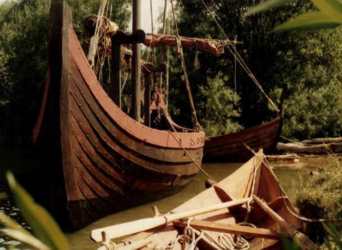 |
It is important to understand that there were many different types of ship. There were small rowing boats that might be handled by a couple of men each pulling two oars each called Faerings. Trading vessels which had a virtually fixed mast and only four oar ports in their fifty foot length known as Knarrs. Also the great Drakkars, the warships that were over a hundred feet long and had crews of more than a hundred men. There were Karvs, a sort of multi purpose ship that could trade and/or raid and it is one of these ships that was found at the end of the last century at Gokstad in Norway. This find gave birth to many replicas, based upon this well-preserved hull. In the closing years of the nineteenth century, the first of these was sailed across the Atlantic to the World's Fair in Chicago. I understand that the hull is still to be seen by the shore of Lake Michigan and is itself one of the oldest ships on the North American continent!
During this century, several other ship finds have been made, adding to our knowledge of this fascinating type of vessel. The importance of the ship to the Scandinavians of a thousand years ago cannot be overstated. Truly, without them, there would have been no Viking age and Europe would be a very different place today.
The mobility of their shallow draft vessels allowed the Vikings to travel far up the rivers which flow into the seas surrounding the European continent. The Swedes seem to have specialised in trading down the river systems from the Baltic into central Europe and so to Constantinople. They called the place 'Miklagard', literally 'The Great City'. From this trade route, luxury goods like silk and spices were brought north and sold in specialist trading communities like Birka and Hedeby.
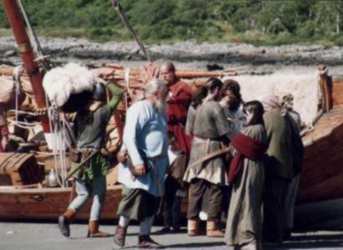 |
Norwegian and Danish Vikings tended to look more to the west. They traded and raided around the western seaboard of Europe and its islands. It was these people who explored and settled Iceland, Greenland and finally North America. There is now no doubt that there was a Viking settlement in Labrador. However, this represented the limit of reach of their settlements and it is unlikely that they stayed there long, possibly only a few years. It is my opinion that when Leif Erikson went to North America, he did so knowing that it was there. It was likely that the expedition went there for wood more than from the pure spirit of exploration. The site in New Foundland known as Lans aux Meadows, is now beginning to throw up finds that suggest they even went further south.
There are records of other visits to America, some of whom never returned. Sailing the North Atlantic in an open boat - however seaworthy - is a dangerous business and it is more than likely that those who never returned were simply lost at sea. It is fun to speculate, though, on the report that Cortez brought back. He said he was initially welcomed by the inhabitants of South America as a representative of those pale-skinned seafarers who had visited that part of the world centuries before........
It must have seemed like a continuing nightmare to the largely peaceful settlements around the coasts of Europe and its islands. Suddenly, in the closing years of the eighth century, the Viking raids began. They often came in on the morning sea mists, their shallow-draft vessels creeping quietly through the reeds of the river mouths or sliding silently up on sandy beaches. Quickly, the raiding party would assemble and work its way inland. Their early targets were the churches and monasteries, looking for silver, gold and slaves. Soon, these were depleted and the raiders attention turned to the more mundane victims of farm and village for food and horses to make their getaway. As the years slipped by, so the sea raiders came more and more often. Sometimes, they would stay over-winter and gradually the raiders camps turned into settlements. At one time, most of England was under the Viking heel and they called this part of the country the Danelaw.
The turning point came when Alfred the Great beat Guthrum in a straight fight and forced him and his important men to become Christians. After that, every year saw first Alfred and then his kin pushing the Danish invaders further and further north. They did this steadily, setting up Burhs or fortified towns. (One example of this as place name evidence is Middlesbrough.) Eventually, in the reign of Æthelstan, the whole of Britain came under his kingship.
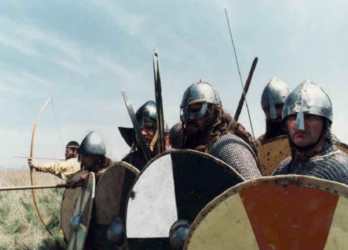 |
Around the turn of the millennium there followed a period of state-organised invasion. Hundreds of ships would turn up regularly each year with thousands of men. They were intent upon making Britain politically part of Scandinavia and they could only be bought off with ever increasing sums of Danegeld, as it became known. 20,000 pounds weight of silver was a not unusual sum and it proved a crippling load on the economy of the English state. But curiously, despite the vast sums of money going out of the country, it held together and only fell to Cnut after a large defeat in battle at Ashington in Essex.
Eventually, in 1016, the English Witan turned to Cnut, king of Denmark and asked him to become king of England. He proved to be a good king and spent much of his early reign settling the affairs of ravaged parts of the kingdom and re-settling them. For instance, there is some evidence that he spent a whole year in the Isle of Wight, setting things to rights there.
Substantially, the reign of Cnut (or Canute) represented the end of Viking military incursions into England, although there were sporadic raids around the coast for some time. The last great fete of Scandinavian arms in this country was in 1066, when king Harold Godwinsson, last Saxon king of the English, brought King Harald Hardrada of Norway to open battle at Stamford Bridge near York. In a crushing decisive victory, King Harold broke the power of the Scandinavian kings to wage overseas war on a large scale. It was the final major Viking raid.
For a people who were so careless of the rights of the folk they fought against, the Vikings were surprisingly organised and careful of their rights at home. There was a strict system of law, enforced by the people that lived under it. Regular meetings - called Things or Althings - were held at which the Law was read aloud. (This custom survives to this day in the Manx Tynwald.) At these meetings, cases were judged and punishments imposed by a council of important men who were changed from time to time. Every free man or woman had the right to speak at an Althing. Women were generally held to be the equal of men under the law. They retained their rights to manage their own money and property after marriage and could obtain a divorce with the same ease - or difficulty - as a man1. Women only became second-class citizens after the imposition of Norman Law!
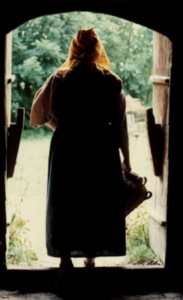 |
The Vikings ate a wide range of foodstuffs, but there are no real surprises. Beef, mutton, pork and venison were common meats, and communities close to the coast could expect to widen their diets with fish and shellfish. A heavy bread made from barley flour was common, but there is evidence that at least some people had wheaten bread available to them. It was often the custom to eat gruel - a porridge augmented by scraps of meat as a morning meal. Boiled meat was much more common than roasted, something which was normally only eaten during ceremonies. Boiled sausages known as 'cauldron snakes', were a special delicacy. Other sought after foodstuffs were sun-dried cod, ling and pork that had been preserved in whey, then boiled to rags in its juice. Yuk!
It is reasonable to assume that rich folk ate better than poor, but their range of foodstuffs would not have been very different.
The Vikings were a proud, honourable, law-abiding people who valued warfare and personal reputation (they called it 'word fame') above almost anything else. In the latter years of the Viking Age, they became involved in their own myth, starting such organisations as the Jomsvikings.
They brought the seafaring ship to Europe and, by their constant depredations, spread its use far and wide. In only 250 years, they set their mark on the law and language of many countries and made many European communities see themselves in the light of a nation state for the first time. In terms of human history, if you blinked, you would have missed them! But the image the Vikings promoted of the brave, hardy individualist, unafraid of the world in all its forms, remains with us all as an example of how a man should conduct himself in adversity.
'Wealth dies, kinsmen die. Cattle die and the wheat, too.1 Note that women were, in general, not permitted to address the thing, where a male relative would often speak for them. (For further reading, Women in Old Norse Society, J. Jochens, 1995)
But this thing never dies: word-fame!
Word-fame never dies for he that achieves it well.'
Click here to return to the village.
Click here to return to the 21st Century.